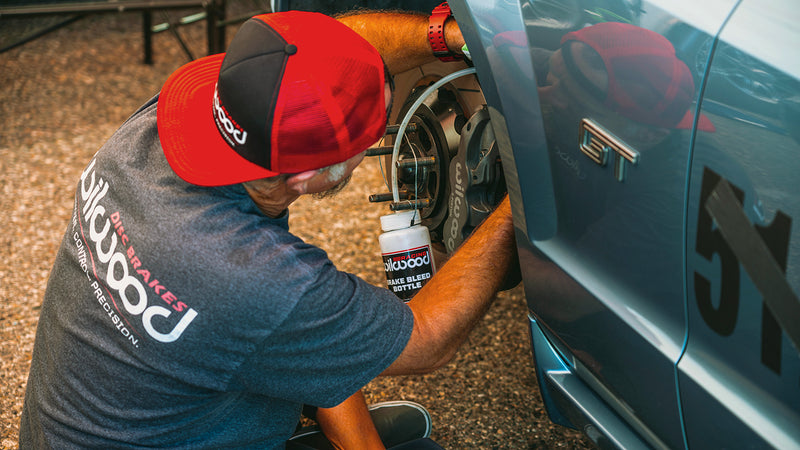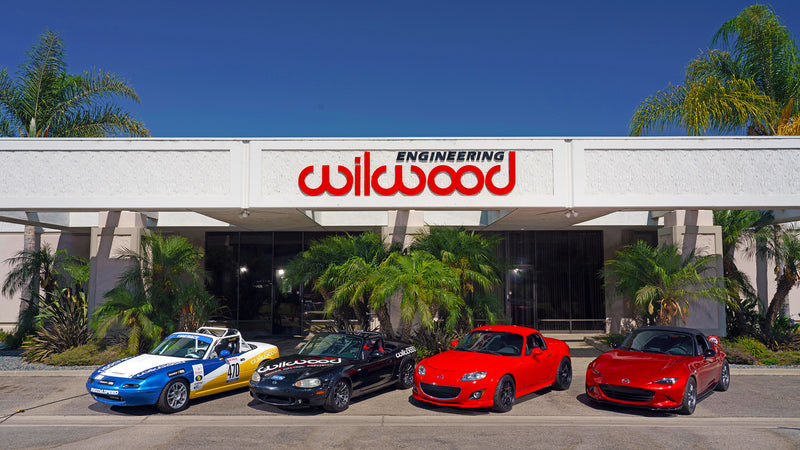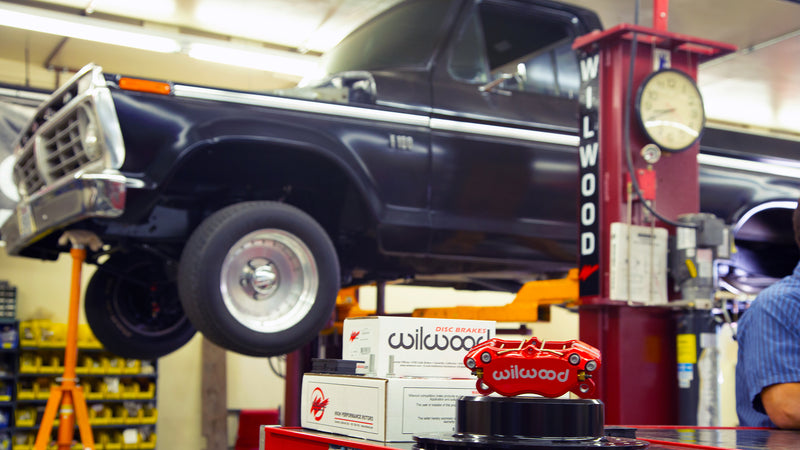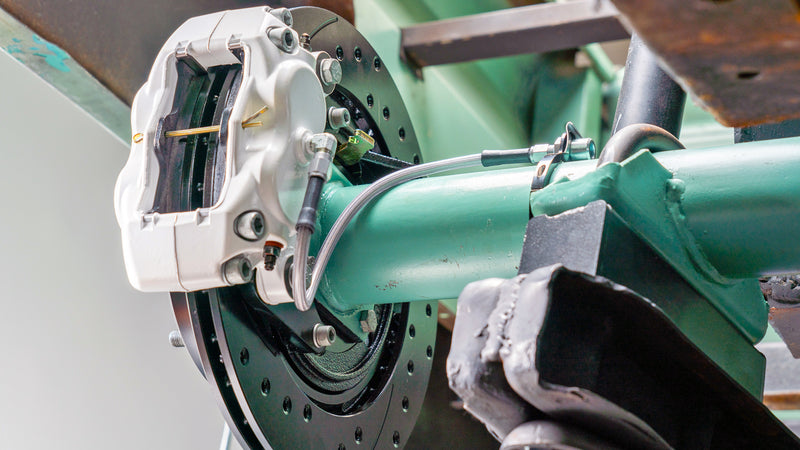
The hydraulic brake system of your car or truck is a sealed system. That means whenever you unseal it or replace a part, you will have to bleed all the air out of it. Air is a fluid, and obviously, brake fluid is a fluid, and they cannot occupy the same space at the same time. However, the air can be compressed, which is what it will do instead of applying the brakes if you don't remove it.
These instructions apply to most street cars and race cars with a tandem master cylinder. Race cars with two separate master cylinders on a balance bar are different and require bleeding two wheels at a time, one front and one rear (purge bleeding instructional video).
Bench Bleeding the Master Cylinder
The easiest part of bleeding the brake system is bench bleeding the master cylinder, though it requires taking it out of the car. If you are installing a new master cylinder, Wilwood or OEM style, it is already out! But test fit it to the firewall/booster first and make sure everything is right, including the pushrod length, before putting fluid in it. It is a lot less messy that way.
It is crucial you bench bleed the master cylinder because, as mounted to the car, it is impossible to get all the air out of the piston bore. You will never have an appropriately firm pedal as long as there are still air bubbles that need to be compressed in front of the piston, and there is little chance they will find their way out on their own. The only escape the bubbles have is back into the fluid reservoir through a tiny hole at the back of the bore, and most cars mount the master cylinder flat or at a slight upward angle, trapping air at the far end of the bore.
Bench bleeding is easy, but you will need a bench-mounted vice to hold the master cylinder.
- Clamp the master cylinder in a way that won't damage it, typically by the mounting flange.
- Try to get it level, or even with the front pointed down slightly, so air bubbles can escape through the compensating port or brake outputs.
- Thread plastic fittings into the output ports, and route the hoses back to the reservoir.
- Pump the piston with a dowel, screwdriver, or the attached pushrod slowly through its entire stroke several times, then several short, fast strokes.
- Continue alternating until you no longer see bubbles in the hoses.
Now you are all set to reinstall the master cylinder in the car and connect it to the brake lines. Careful not to drip any brake fluid on painted surfaces.
Bleeding the Brake System

After connecting the brake lines to the master cylinder, proportioning valve, and all four calipers, it is time to bleed the whole system to fill the calipers with fluid and purge any air in the lines. This is the same process you would use to flush the system of old fluid and fill with higher performance Wilwood High Temp 570 or EXP 600 PLUS brake fluid. Most people neglect this maintenance on daily drivers, but even on commuter cars it is essential to flush it every other year and every year on any car driven hard. Many racers flush out the old fluid after every race weekend, if not every race!
The most critical aspect of bleeding brakes is not to let any air back into the system. You will need an assistant to pump the brakes on command, or you can employ one of the many one-person brake bleeding techniques, like the Wilwood Brake Bleeding Bottle. With an assistant, you have them pump the brakes and hold the pedal, then you loosen the bleed screw to let out the air bubbles and fluid. With a bleed bottle, the bleed screw nipple is attached to a hose submerged in brake fluid, and you pump the pedal yourself with the screw open; the fluid keeps air from being sucked back into the caliper. Then repeat over and over until there are no bubbles.
You can also bleed the brakes with a vacuum pump or syringe. With a vacuum pump, you suck the fluid through the system via each bleed nipple, displacing the air. With the syringe, you inject fluid into the caliper through the bleed screw, and it pushes any air bubbles back into the reservoir. Follow the directions that come with these tools for a more detailed explanation.
Note: Most Wilwood calipers have two bleed nipples and some have four. Never bleed the lower screws that point downward. They are only there so that the caliper can be used on either side of the car.

- Start with the wheel farthest from the master cylinder, usually the right rear for left-hand drive cars.
- Put a hose on the outside upper bleed nipple connected to the bleed bottle or a catch can.
- Have your assistant pump the brake pedal, then hold it, loosen the bleed screw and let out the air and fluid, then close it.
- If you have no assistant, make sure the hose's end is submerged in the bleed bottle, loosen the screw, then pump the brake pedal.
- Repeat until only fluid shows in the hose with no air bubbles, then tighten the outside bleed nipple and attach the hose to the inner nipple.
- Repeat the procedure on the inner nipple.
- Check the fluid level in the master cylinder as you work. If you pump all of the fluid out of the reservoir, you will have to start all over again.
- Repeat the process with each wheel, moving successively toward the master cylinder. Right rear, left rear, right front, and finally left front.
- Refill the master cylinder reservoir and replace the cap.
Once you have a nice firm pedal, replace the wheels and tighten the lug nuts to their proper torque values. Now is also an excellent time to check for fluid leaks at the calipers and brake line fittings.




Jim,
Sorry for the delay in getting back to you. Have you had any luck with getting your brakes bled?
There is no check valve in the bleed screws. They are a two piece design and you should only loosen the tiny 1/4” hex upper part.
If you have the time, we recommend letting gravity do the initial bleed. Fill the reservoir, Crack open the bleeder furthest from the master cylinder (rear passenger side), and let it drip while you go out for lunch. Then do the other rear wheel. Then the fronts.
One you have fluid dripping out of each caliper, you can do a final bleed by pumping and holding or vacuum.
Bryan
I have installed Wilwood disc brakes on all 4 wheels. I have the air operated bleeder kit but it doesn’t seem to pull any fluid. Have used it on other cars with no problem. Do Wilwood bleeders have a one way check valve stopping me. Thank you,Jim
Jeremy,
Unlike factory combination valves, there is not connection between the front and rear circuits in the Wilwood adjustable combination valve. In a factory valve, the switch between the circuits is connected to the dash warning light to inform you if the front or rear circuit loses pressure. The switch in the Wilwood combination valve is there to make wiring up the brake light on the back of the car easier, especially with aftermarket pedals. There is no need to do anything other than bleed the brakes as if it wasn’t there.
After bleeding be sure to adjust the knob according to the instructions included to optimize the rear brakes.
So I have bleed a few brake systems in my life I am going put a wildwood adjustable proportioning valve on my jeep. I have bleed a few systems from empty and tripped the proportioning valve and had to reset it and use that tool to hold it for bleeding I don’t see a way on this adjustable vavle to do that by removing the brake switch on stock style vavle what do I need to do if anything on the wildwood vavle
You are correct Kenneth, you only need to bleed air from the screw pointing up as installed, and to bleed you only loosen the small 1/4" screw. Wilwood calipers have bleed screws pointing up and down because we manufacture them for installation in a variety of positions. For instance, we only have to make one D52 caliper to fit the left or right side of the vehicle. If you prefer, the bleed screw pointing down can be replaced by an ordinary 1/8-27 NPT plug.
Is it correct to say that for normal bleeding (D52) only the smaller inner screw on top is used ?
William,
The bleed screws are super simple, so there isn’t anything that usually goes wrong with them. The smaller inner hex head tightens the bleed screw into the seat (the larger hex head threaded into the caliper) – a tapered end on the bleed screw seals in a corresponding taper in the larger outer bushing.
You can also call our tech line at (805) 388-1188 6:00am – 5:00pm PST Monday – Friday and talk directly to someone with any questions.
I too can not bleed fluid thru the breeders. I can loosen until it bleeds from the threads. What needs to be done so the breeders bleed properly.?
Randy,
You do need to bleed both of the top screws to ensure there is not an air bubble trapped in the caliper between where the crossover is and where the bleed screws are (the highest point).
Is it OK to bleed just one bleeder screw on top of each caliper or do you have to do both top screws
Darren,
The simple answer as to why you bleed the outside nipple first, then the inside one, is that the outside bleeder is further away from the source of brake fluid. The fluid will displace the air in the near side of the caliper first as it fills. The internal crossover tube is significantly lower than the bleed screws, so it is unlikely air will travel back down and crossover from the far side to the near side once it has been bled.
Nothing bad will happen if you try to bleed the lower screws. Chances are there is enough fluid in your caliper that it will just drip out those bleeders and keep any air from getting in. Air rises in the fluid, so any air trapped in the brake caliper will be at the top bleed screws.
As for the leak at the caliper fitting, some calipers use a banjo bolt, but most Wilwood calipers use a fluid inlet with 1/8" NPT thread, which was originally named that because of an 1/8" internal diameter (not the threads) pipe, and NPT comes from National Pipe Tapered. The threads are tapered and seal better the more you screw them in. There is no washer used as the seal is in the threads themselves.
1) Make sure you wrapped the threads properly with sealing tape or coated it with the paste
2) There is no torque spec for proper sealing, instead the fittings should be tightened finger tight, then tightened at least 1.5 more rotations, then tightened to point in the proper direction.
What is the reasoning for bleeding the outside bleeder nipple first, and inside second? I’ve always assumed it’s best to do inside first and reduce chances of any air getting stuck in caliper in the off chance not all the air is removed from the first bleed of the two bleeder nipples…have always wanted to be sure whats best and why. Thanks!
I have 4 bleed screws and I bleed the lower bleed screws on a pair of your calipers what can happen and the caliper fitting leaks at the caliper is there a washer between caliper and fitting
John,
Here are a few suggestions:
1) Make sure the pedal and master cylinder piston return all the way to their proper resting position. If the master cylinder piston doesn’t go back all the way to the stop, the port which feeds fluid from the reservoir to the bore may not be uncovered. You say you get fluid when you pump the pedal, so it must be close, but it is possible that at rest the port is covered. More details are here – https://shop.wilwood.com/blogs/news/troubleshooting-no-fluid-pressure-at-the-rear-brakes
2) Ignore the bleeder screws that point down when the caliper is installed, you only have to bleed the ones that point up.
3) There may be more air than you think in the system. Is the vacuum bleeder holding a vacuum but not pulling any fluid?
You can call our tech line during normal west coast business hours on weekdays, and they will be able to help you trouble shoot in real time much better than I can here. – (805) 388-1188
Hi, I just installed the calipers on my Alfa Romeo spider from Centerline. I can’t seem to suck any fluid with my vacuum bleeder or pressure bleeder. I can get a stream If I pump the brakes though. Is there an issue with the hardline as it goes into the caliper fitting or some other blockage? I’ll try the bleed bottle method..there doesn’t seem to be enough room on the nipple for both a wrench and tube though?
I have wilwood front disc brake kit and new wilwood master cylinder but bleeder screws will not let fluid through!! I have done all steps in bleeding but no peddle pressure! I even put bleeder screw on power bleeder held it in brake fluid and no fluid will go through bleeder! I am lost! If bleeder screw is out should I be able to blow through it with air?
Daniel,
There is no need to “fix” anything. There is no harm in bleeding both screws as long as you get all the air out. Since air rises, once you have installed the D52 caliper and pumped fluid into it, there won’t be any air trapped near the bottom bleed screw. In the future, when you replace old brake pads or during an annual fluid flush, you only need to bleed air out of the top screw. Opening the lower screw will let fluid drip out and can let air in.
Hi , I have your gm d52 calipers . I ended up bleeding both bleeder nipples on the caliper . what will happen since i bled the bottom screw and how could i’fix it . thanks
Hello Douglas –
We would need to gather a few pieces of information to help point us in the right direction and get you down the road. Factors such as master size, booster size, pushrod adjustment, and the specific calipers that are on the vehicle. Please reach out to go over the information as there are a few factors at play.
Have a great one.